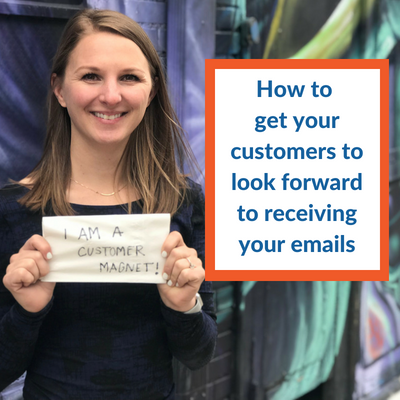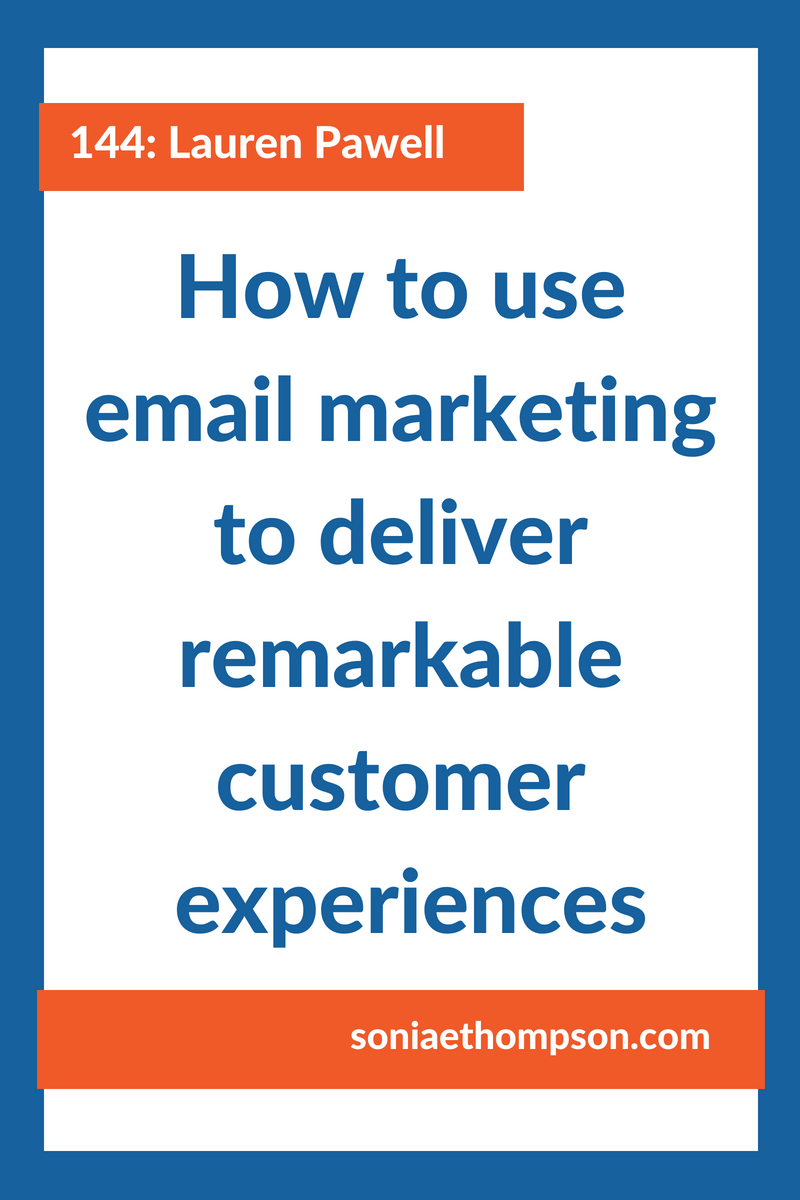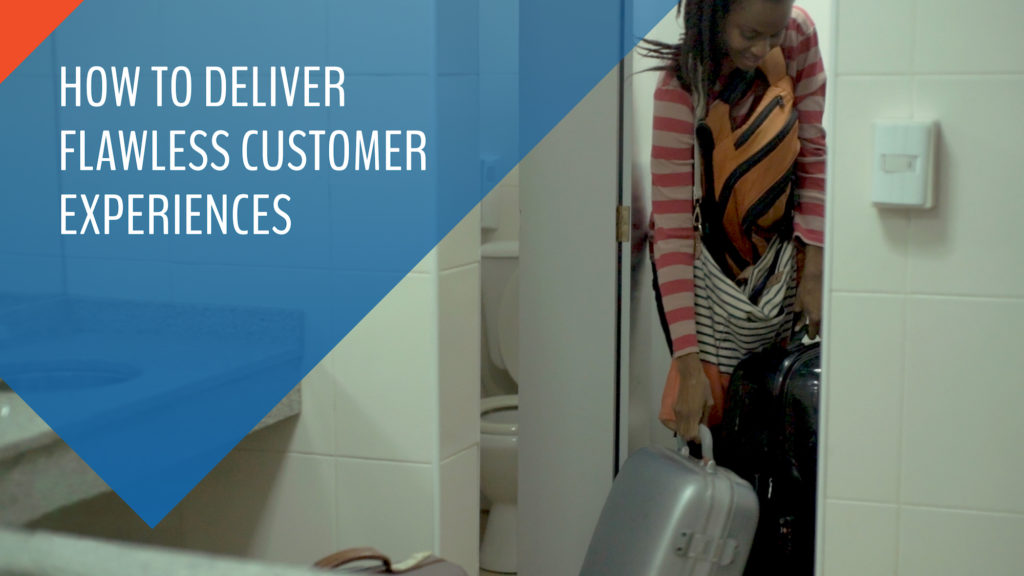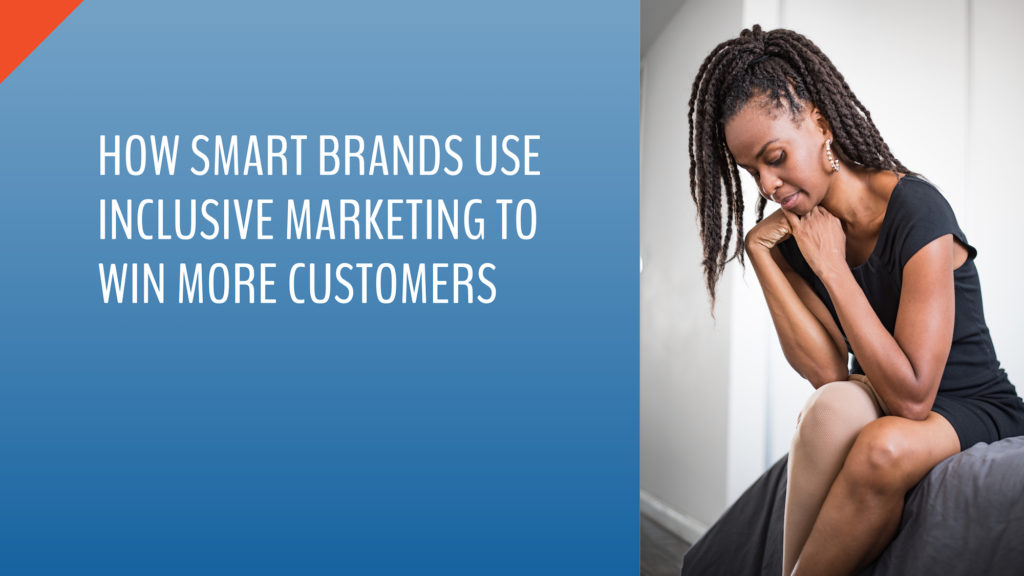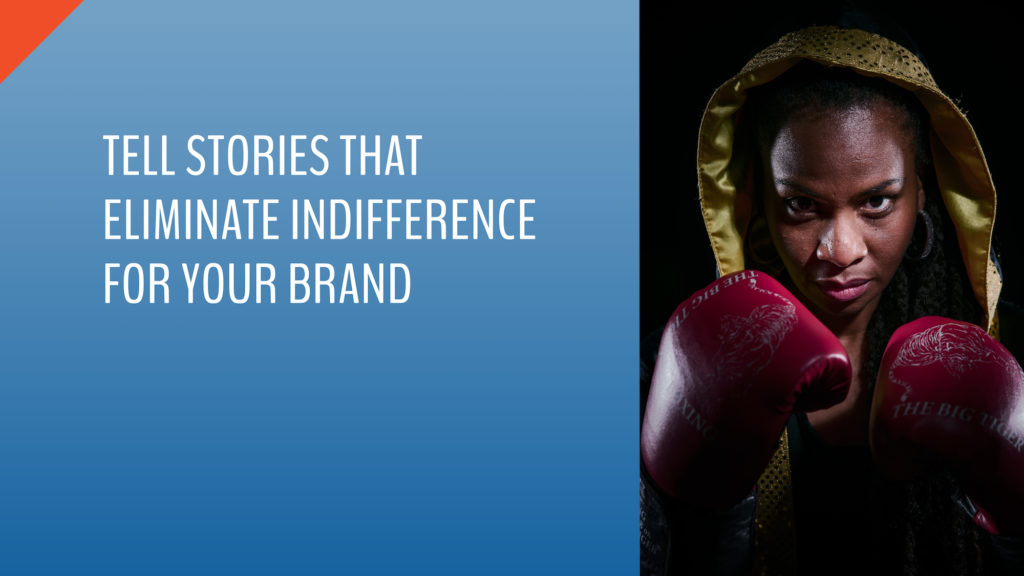Today we are talking about email marketing, and specifically how to use it to deliver remarkable experiences to your customers that ultimately grow your business.
And to dive into this topic, I chatted with Lauren Powell, founder of Bixa Media, where she is an email marketer extraordinaire.
We can learn a ton from Lauren, in particular how to get your audience excited about seeing a message from you in their inbox.
Key points:
- Ways to use email marketing to connect with your customer throughout every touchpoint of their buying process
- How to get your customers excited about receiving an email from you
- Simple ways to create an emotional connection with your customers through email
- Why every email shouldn’t be a “sales” email
- Smart ways to find engaging content for your emails
- A common myth about email marketing that you need to ditch once and for all
- Key metrics to measure the success of your email marketing efforts
Listen to the 22-minute episode here:
Watch the episode here:
Read a transcript of the episode here:
How to deliver remarkable customer experiences with email
Sonia Thompson: Hello Lauren, thank you so much for joining me today. How are you?
Lauren Pawell: I am good. I am so excited to be here.
Sonia: It’s always fun chatting with you. Alright, let’s go ahead and dive right in because we’re talking about a super cool topic, but first tell me about your business Bixa Media.
Lauren: Yeah, so Bixa Media is a marketing agency where we help customers generate, nurture and convert. more leads online and a big part of that is what we’re going to be talking about today, which is email marketing.
Sonia: For sure. Alright, tell me … you talked a little bit about it, but what is the specific problem that you solve for the people that you serve?
Lauren: Yeah, so my clients want more business and they want to get that business online. So, they may have great offline revenue streams or ways of acquiring customers or they may not and they’re just looking to generate more customers and revenue online.
Sonia: Sweet and why do your customers choose you to help them solve this problem?
Lauren: Yeah, this is a great question and someone was just asking me about this the other day and I was walking through what my client’s store might look like and most of them have already worked with a marketing agency of some sort typically to build the website. And lo and behold they build a website and they launch it, they realize that alone does not bring you customers.
Sonia: Nope.
Lauren: So they’ve gone through that whole show and then we have a conversation about the bigger picture of the marketing strategy, how we’re going to drive traffic, how we’re going to drive qualified leads to the website and how we’re going to nurture and qualify them. That’s typically why they choose me because we have more of a partnership and in many ways it’s an education for the client rather than the client just saying “I want a website, go.”
Sonia: Well that’s an interesting insight in terms of how people find you because you hear this all the time where people they want a website and generally people understand websites and they understand the need for it. They understand why it’s beneficial but like you said they don’t necessarily connect the dots on oh, well what do I do with the website once I get it? How is it going to actually function to be able to drive business results for me?
That’s when all these other components get into it. So, it’s interesting to see how many clients get sort of … or customers, companies, businesses get stuck in that world of having tools, but not really knowing how to get the full benefit of the tools that will actually help them serve their customers better.
Lauren: Yeah and the tool is often the shiny object.
Sonia: Yeah.
Lauren: But it’s about how you use and employ that tool and I think even a website could be a great lead generator. But if you’re just thinking about it and working with someone as, “Hey I’m really focused on the colors and the appearance of my website,” but you’re not thinking about who am I speaking to and how am I moving them through that, then it’s not a very great tool, right?
Sonia: Yeah, yeah. A tool is only as good as how you use it, right?
Lauren: Yup.
Sonia: Alright so how are businesses able to use email marketing to deliver remarkable experiences for their customers?
Lauren: So I love the piece of this question that is “deliver remarkable experiences” because you can use email marketing to create a lot of different touch points for your customer, but to deliver that remarkable experience is a lot harder to do. I think the beauty of email marketing is that you can be in touch with people throughout the whole process from before they’re even a customer and then all the way through to after they’re a customer and how do you follow up with them and how do you make sure they’re happy on an ongoing basis. How do you get referrals?
So, really understanding where someone’s at and what they need at that point in time will allow you to deliver a remarkable experience through the email content that you’re providing. So, being able to segment where someone’s at in the buying process and what they need I think is really important.
Sonia: Got it. So it sounds like you’ve got to really have a deep degree of customer intimacy as well to know what it is that they’re going to want and need and that segmentation you said as well.
Lauren: Yeah, yeah so think about like if you’re going to buy a car and you’re thinking about buying a car you might be very early on and you have no idea what kind of car you want to buy. Or you might be at the point where hey I know I want a Toyota Tacoma. I’m just trying to figure out which … who I’m buying it from.
Sonia: Right.
Lauren: So what kind of content you’re going to deliver to those two people over email is going to be very different.
Sonia: Absolutely.
Lauren: But if you’re telling me about Toyota Tacoma’s and I don’t even know that I want a Toyota Tacoma, that’s not very remarkable.
Sonia: Right.
Lauren: In fact, it’s just annoying.
How to deliver emails your customers will look forward to reading
Sonia: Yeah. Yeah, so speaking of annoying, most people aren’t really fans of email and I’m one of these people that I just like oh my gosh, there’s so many emails in my box. That’s kind of like how I feel a lot of times. So you rarely hear people being excited about receiving email from a person that isn’t a personal friend or family member or something else. What can businesses do to make receiving an email from them something that their customers are really excited about?
Lauren: Yeah so you almost answered the question in your explanation. But you said I’m really only excited about receiving emails from friends and family members, right? So those are personal. They’re talking about something interesting to you. And a lot of businesses don’t take that approach when they’re sending emails. They put some pretty banner in the header and then they send you an email about an offer or one sentence. And it’s really not that engaging or something you really want to receive.
And so I think if you take a more personal approach and also you’re understanding where someone is in that buying process, then of course the emails are going to be relevant and of course it’s going to be something that someone looks forward to especially if you have some of component that’s engaging and inspiring, entertaining or connecting in some sort of way.
Sonia: Okay, now a lot of businesses that aren’t necessarily one-person businesses or five-person businesses … sometimes even though smaller businesses struggle to do that as well. They struggle with that personal aspect of it and of course the emails end up feeling very transactional. So how can people use email? What are your recommendations for how to use it to deliver a more deeper emotional connection so it actually does feel like it’s coming from a friend or a loved one and it doesn’t feel weird or creepy or like you’re trying too hard to be cool?
Lauren: Yeah. Two things. One, you can experiment with sending the email from an individual at the company which I know big brands tend to feel a little weird about but often times that works really well. HubSpot does this really well. They’ll assign you someone-
Sonia: Matt from HubSpot, yeah, HubSpot.
Lauren: Exactly. That’s something you’re more likely to open because it looks more like a friend’s email than something like HubSpot. Then in terms of how to keep the content engaging I think you can always get great inspiration from design-oriented brands or e-commerce stores like I’m thinking right now about Glossier or Soko Glam. But they do a really great job of sending an email from the brand but there’s some sort of something exciting in it or they’re just talking to you like, “Hey, it’s Friyay,” or something like that and obviously their customer is very millennial oriented so I wouldn’t suggest that for everyone.
But if you’re speaking to someone’s pain points, struggles or something they’re interested in, then at the end of the day it’s going to be something you want to read. And you want people to think when they receive your email, “Oh, I’ve been waiting for this. Oh, I’ve so been looking forward to this.”
Sonia: Right. Should storytelling be a component of it? Is that a way to transition from the transaction to something that connects more deeply?
Lauren: Yeah, definitely storytelling’s a great tool. I think anytime you can incorporate story in anything it becomes more engaging even if it’s to share some of educational lesson or even to lead into a promotion or something that’s more transactional. But if you can relate it to some sort of story that connects with people, that’s just another way to get an emotional connection from that email. So if you read the email and you’re like, “I’m bored to tears,” then probably your subscriber’s going to be bored to tears as well.
Sonia: Right. If you don’t have any emotion associated with the email then you can’t expect anybody else will either, right?
Lauren: No. No, exactly.
Best practices for delivering remarkable email marketing campaigns
Sonia: All right, so what are the best practices that you recommend your clients engage in with their email marketing efforts?
Lauren:
Yeah so from the content side if you can do some content research ahead of time, there’s so many pieces of content out there that have been proven to drive traffic, get shares, things like that. So you can do this on answerthepublic.com or just looking at YouTube or Amazon books and finding content that resonates with people already and you can already see sales are being generated maybe it’s from someone else. And then you put your own spin on it. That’s a great way to make sure that your content’s engaging and if you do that research ahead of time perhaps every quarter and then you can map out your calendar, you’re far more likely to create a cohesive story rather than what a lot of people do is, “Shoot I have to send an email today. What am I going to write?” That’s just not a great way to create any sort of engaging content. Plus it’s a sure fire way to have broken links, typos. I think we’ve all been guilty of that.
Sonia: Right.
Lauren: But you’re not leading someone down a path which is ultimately what you want to do because you’re not going to be sending promotional emails all the time. Some of it’s going to be more educational or entertaining with the goal of eventually getting that sale.
Sonia: Is there a ratio of educational to promotional or promotional to other types of emails that you recommend that people follow?
Lauren: Yeah, I like 80/20 but you could do 70/30 or 60/40 as long as more of it is educational and the rest is promotional. Now, I use the term educational loosely. It could be entertaining or it could be something else but people often are like, “Well if I’m not selling all the time then what’s going to happen?” At the end of the day you are still selling. You’re just selling your brand in a different way without having that concrete CTA at the end that says, “Buy this now for 10%.” But you’re still selling ’cause you’re building someone up and you’re moving them through that buying cycle.
Sonia: Right. Another key component in what you mentioned is that it sounds like planning is a big aspect of this. In planning is there a certain time frame that you should be planning in advance like is it a month? Is it three months?
Lauren: I like three months because I find especially if you’re doing maybe like a cart open to close or you have a heavy promotional period like Black Friday and then Christmas. Then you can do that 80/20 rule a little better because you will then see, okay we’re going to have some heavy promotion for this month and a half. What are we going to lead up? What are we going to do that’s more educational that’s going to lead up to that?
Where if you just have a month and you’re really … people frequently are only sending emails once a week. That’s only four emails and that’s often not enough time to look at what’s the bigger picture and how am I leading people through these campaigns?
Sonia: Right. Got it. All right, so what are the biggest myths that you hear about email marketing that you would like to dispel once and for all?
Lauren: Yeah. I don’t know if this is a myth but, I guess it is, but people feel like if they send emails they’re going to be seen as spamming. A spamming salesperson. And at the end of the day if you’re creating engaging, compelling content and you’re attracting the right people, then it’s not going to be spammy. And people who leave aren’t your right audience so that’s okay if they leave because you don’t want to be spamming people who don’t want to hear from you.
So I think that myth that I’m a spammy salesperson if I send emails is far from true it’s just a question of what are you sending? Maybe you’re not sending the right stuff.
Sonia: Are there certain metrics that you should be tracking that let you know how your emails are working for you of if there are things that need to be tweaked?
Lauren: Yeah. On a basic level open rate and click-through rate and open rate is a measure of are people receiving your email in the Inbox and is it compelling enough to open? So those are two different things. Click through rate, is your content compelling enough to take the next action?
Sonia: Right.
Lauren: A couple of other things you want to be monitoring, subscriber growth. Its’ not just about the emails you send but is the list growing? Deliverability? Are you landing in the Inbox? Sometimes this gets overlooked and you wonder why your open rates are declining and maybe you’re not making it in the Inbox. Maybe you’re in the Google promotions tab or in the spam folder or perhaps you’ve even been blacklisted so you’re not really being delivered at all which has happened and is unfortunate and it’s hard to come back from. So you want to make sure you’re never in that position where that’s an issue. So by monitoring your open rates and making sure things aren’t drastically dropping you can stay clear of any issues along those lines.
Then you don’t want to put too much weight in this but you do want to keep an eye on subscriber rate. If all of a sudden you’re getting a ton of unsubscribes, maybe it was the wrong audience. But maybe it’s also the content you’re sending. So you want to just keep an eye on that. But you also don’t want to say, “Every time I lose a subscriber it’s a problem.” That’s not always the case.
How to get your business ready to deliver email marketing campaigns
Sonia: Got it. Okay. Now, who within an organization should be the one writing and managing an email marketing campaign?
Lauren: Yeah, so the word should is almost like a trap. If you have a copywriter on hand, I think that’s a great person to write the copy because frequently who’s sending and monitoring may not have the same skillset. I don’t find this is often the case. I find typically even in bigger companies you have one person in charge of a lot of marketing tasks and are probably doing a little bit of everything.
If that’s the case maybe having someone outsource who’s just keeping an eye on things for you or providing some guidance I think can be really helpful. But frequently it’ll be some sort of marketing coordinator. Ideally it’s someone who’s connected to all the other promotional events that are going on in the company because your emails should be in line with that.
Sonia: Absolutely. Yeah, ’cause I think sometimes people will just, “Oh just send an email. Just write it.” But when it comes to delivering something that’s remarkable and connecting on a deeper more emotional level, there is a degree of skill that’s associated with creating content that people want to read and that also point you in the direction of taking your customer on the journey that you both want them to go on.
Lauren: Yeah, it’s a subtle both art and science and so if it’s just handed off to a VA or someone who maybe doesn’t understand some of the intricacies, then there could be a challenge like getting blacklisted which is not something you really want to ever face especially if your list is a primary driver of revenue which it often is.
Sonia: For sure. How much time do you need to engage in an email marketing before you start to see meaningful results?
Lauren: It depends. It depends a little bit on your list size. It depends on the quality of your list where people are at. But a really great way to start is just by emailing your existing customers or past customers. You can often see additional sales just from that pretty quickly ’cause that audience is already warm and already knows, likes and trusts you.
So that shouldn’t take that long. A month maybe two. In terms of ongoing campaigns and how that interacts with the rest of your list that maybe is cold or new leads, that a little bit depends on your sales cycle. If you’re buying a new home, big ticket purchase, that might take 12 months to warm you up and then you’re ready to do it. But if it’s just a software demo for 19 bucks a month then that’s a whole different scenario, right?
Sonia: Yeah. Yeah. There are so many different nuances to email marketing but it’s such a powerful thing. I think the latest stat that I heard is for every dollar you invest in email marketing returns back 44. So it’s definitely something that should be a part of everyone’s marketing mix. Most businesses, it should be a part of their marketing mix. So if people want to learn more about this because you know all the ins and outs and all the details, where can people find you?
Lauren: Yeah. I created something special for you guys on this podcast. If you just text to the number 44222 and then you do C as in the letter C and magnet so customer magnet, I’ll send you some free resources and some other great stuff. And if not you can just head to my website which is bixamedia.com. I got a lot of great stuff there as well.
Sonia: Cool and I’ll have that info in the show notes as well so people can access it easily if they don’t text you right away. Maybe they’re driving. We don’t want them to be texting and driving.
Lauren: No.
Sonia: All right, so any parting words of wisdom for businesses who want to us email, email marketing in particular, as a way to deliver remarkable experiences to their customers?
Lauren: Yeah, don’t wait ’til it perfect to get started because a lot of this is a bit of a learning curve and you’ll get better the more you do it. So I would say if you haven’t implemented email marketing now you should have been started yesterday. So go get started. Plan out your next four emails based on some content research and then just get them scheduled and sent out. And the nice thing about that is when you’re doing that advanced planning you really have to think about it once a quarter and then just be monitoring metrics. So it’s a lot easier than a lot of other marketing tactics that you’re going to employ. And it adds a lot of value to other stuff that you’re doing.
Sonia: Yeah, and I don’t think it costs as much as a lot of the other marketing tactics either.
Lauren: No. No, you’re not investing. It’s not like Facebook Ads or going to conferences. And it just layered on top of going to conferences and layered on top of running Facebook Ads, you’re going to get far more results out of those two efforts.
Sonia: Yeah. Lauren, this has been fantastic. Thank you again for stopping by and sharing your insights.
Lauren: Thank you. I so appreciate you having me.
Show notes:
- Bixa Media
- Get Lauren’s email marketing resources: Text ‘CMagnet” to 44222
Free Mini-Course: The Customer Magnet Playbook
Free Mini-Course: The Customer Magnet Playbook
7 Essential elements your business needs to consistently win more customers
- Framework based upon in the trenches experiences from 150+ business and thought leaders
- Science-based explanations to support why the elements of the blueprint work
- Action items to help you get some quick wins

